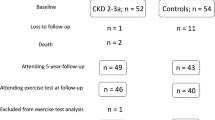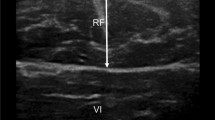Abstract
Background
The goal of the present study was to determine knee extensor muscle strength (KEMS) and degree of renal dysfunction associated with an exercise capacity of ≥5 metabolic equivalents (METs) in male chronic heart failure (CHF) patients with chronic kidney disease (CKD).
Methods
In this cross-sectional study of 75 male CHF patients with CKD (65.3 ± 11.6 years), we measured clinical characteristics, peak \( \dot{V}{\text{O}}_{2} \), estimated glomerular filtration rate (eGFR), and KEMS. Patients were divided into two groups by exercise capacity: ≥5 METs group (n = 41) and <5 METs group (n = 34). Cutoff values for KEMS and eGFR resulting in an exercise capacity of ≥5 METs were selected with ROC curves. Patients were divided into four groups according to cutoff values, and numbers of patients attaining an exercise capacity of ≥5 METs were compared between groups.
Results
Age was significantly higher although eGFR, Hb, and KEMS were lower in the <5 METs versus ≥5 METs group (P < 0.001). Multiple logistic regression analysis revealed a positive significant relation between KEMS and eGFR and exercise capacity of ≥5 METs. Exercise capacity of ≥5 METs was associated with KEMS of approximately 1.69 Nm/kg and an eGFR of 45.7 mL/min/1.73 m2. The number of patients attaining an exercise capacity of ≥5 METs in the patients who did not reach both cutoff values was significantly lower than that in any other patients (P < 0.001).
Conclusion
KEMS and eGFR may be useful indices for predicting attainment of exercise capacity of ≥5 METs in male CHF patients with CKD.



Similar content being viewed by others
References
Myers J. Exercise capacity and prognosis in chronic heart failure. Circulation. 2009;119:3165–7.
Morey MC, Pieper CF, Cornoni-Huntley J. Physical fitness and functional limitations in community-dwelling older adults. Med Sci Sports Exerc. 1998;30:715–23.
Hillege HL, Girbes AR, de Kam PJ, Boomsma F, de Zeeuw D, Charlesworth A, et al. Renal function, neurohormonal activation, and survival in patients with chronic heart failure. Circulation. 2000;102:203–10.
Heywood JT, Fonarow GC, Costanzo MR, Mathur VS, Wigneswaran JR, Wynne J; ADHERE Scientific Advisory Committee and Investigators. High prevalence of dysfunction and its impact on outcome in 118,465 patients hospitalized with acute decompensated heart failure: a report from the ADHERE database. J Card Fail. 2007;13:422–30.
Clyne N, Jogestrand T, Lins LE, Pehrsson SK. Progressive decline in renal function induces a gradual decrease in total hemoglobin and exercise capacity. Nephron. 1994;67:322–6.
Hotta C, Hiraki K, Watanabe S, Izawa KP, Yasuda T, Osada N, et al. Determinants of exercise capacity in chronic heart failure patients with chronic kidney disease. Rigakuryouhougaku. 2011;38:436–41 (in Japanese).
American College of Sports Medicine. ACSM’s guidelines for exercise testing and prescription. In: Johnson EP, editor. Clinical exercise testing. 6th ed. Baltimore: Williams & Wilkins; 2000. p 91–114.
Matsuo S, Imai E, Horio M, Yasuda Y, Tomita K, Nitta K, et al. Revised equations for estimated GFR from serum creatinine in Japan. Am J Kidney Dis. 2009;53:982–92.
Izawa KP, Watanabe S, Oka K, Hiraki K, Morio Y, Kasahara Y, et al. Upper and lower extremity muscle strength levels associated with an exercise capacity of 5 metabolic equivalents in male patients with heart failure. J Cardiopulm Rehabil Prev. 2012;32:85–91.
Suzukawa M, Shimada H, Tamura M, Suzuki T, Inoue N. The relationship between the subjective risk rating of specific tasks and falls in frail elderly people. J Phys Ther Sci. 2011;23:425–9.
Izawa KP, Watanabe S, Yokoyama H, Hiraki K, Morio Y, Oka K, et al. Muscle strength in relation to disease severity in patients with congestive heart failure. Am J Phys Med Rehabil. 2007;86:893–900.
Astor BC, Muntner P, Levin A, Eustace JA, Coresh J. Association of kidney function with anemia: the Third National Health and Nutrition Examination Survey (1988–1994). Arch Intern Med. 2002;162:1401–8.
Padilla J, Krasnoff J, Da Silva M, Hsu CY, Frassetto L, Johansen KL, et al. Physical functioning in patients with chronic kidney disease. J Nephrol. 2008;21:550–9.
Heiwe S, Tollbäck A, Clyne N. Twelve weeks of exercise training increases muscle function and walking capacity in elderly predialysis patients and healthy subjects. Nephron. 2001;88:48–56.
Patel DR, Raj VM, Torres A. Chronic kidney disease, exercise, and sports in children, adolescents, and adults. Phys Sportsmed. 2009;37:1–9.
Harrington D, Anker SD, Chua TP, Webb-Peploe KM, Ponikowski PP, Poole-Wilson PA, et al. Skeletal muscle function and its relation to exercise tolerance in chronic heart failure. J Am Coll Cardiol. 1997;30:1758–64.
Piepoli MF, Corrà U, Benzer W, Bjarnason-Wehrens B, Dendale P, Gaita D, et al. Secondary prevention through cardiac rehabilitation: from knowledge to implementation. A position paper from the Cardiac Rehabilitation Section of the European Association of Cardiovascular Prevention and Rehabilitation. Eur J Cardiovasc Prev Rehabil. 2010;17:1–17.
Massie BM, Simonini A, Sahgal P, Wells L, Dudley GA. Relation of systemic and local muscle exercise capacity to skeletal muscle characteristics in men with congestive heart failure. J Am Cardiol. 1996;27:140–5.
Davies DF, Shock NW. Age changes in glomerular filtration rate, effective renal plasma flow, and tubular excretory capacity in adult males. J Clin Invest. 1950;29:496–507.
Manini TM, Visser M, Won-Park S, Patel KV, Strotmeyer ES, Chen H, et al. Knee extension strength cutpoints for maintaining mobility. J Am Geriatr Soc. 2007;55:451–7.
Conflict of interest
All authors declare no conflicts of interest in relation to the work reported in this manuscript.
Author information
Authors and Affiliations
Corresponding author
About this article
Cite this article
Hotta, C., Hiraki, K., Watanabe, S. et al. Knee extensor muscle strength and index of renal function associated with an exercise capacity of 5 metabolic equivalents in male chronic heart failure patients with chronic kidney disease. Clin Exp Nephrol 18, 313–319 (2014). https://doi.org/10.1007/s10157-013-0818-4
Received:
Accepted:
Published:
Issue Date:
DOI: https://doi.org/10.1007/s10157-013-0818-4




